Review Article - (2023) Volume 8, Issue 7
Received: 22-Feb-2023, Manuscript No. JPNP-23-89870;
Editor assigned: 27-Feb-2023, Pre QC No. JPNP-23-89870 (PQ);
Reviewed: 14-Mar-2023, QC No. JPNP-23-89870;
Revised: 15-May-2023, Manuscript No. JPNP-23-89870 (R);
Published:
22-May-2023
, DOI: 10.37421/2472-0992.2023.9.249
Citation: Devi, Seema. "Review: Approach
of Herbal Constituent in Fertility Regulation." J Pharmacogn Nat
Prod 9 (2023): 249.
Copyright: © 2023 Devi S. This is an open-access article distributed under the terms of the creative commons attribution license which permits unrestricted
use, distribution and reproduction in any medium, provided the original author and source are credited.
Population is increasing day by day but now, it reaches to an alarming position. Various approaches have been applied in the control population. Many studies have been done on the basis of traditional system of herbal medicine. Most of the studies until are mainly based on the plant with anti-fertility activity. Now, this article is further approach in fertility control in both male and female by giving main attention on active phytoconstituent present in anti-fertility plants. In this article active constituents are discussed based on their abortifacient, anti-estrogenic, anti-spermatogenic and their anti-fertility activity based on their mechanism of action in various animal models. In this article we discussed 37 active anti-fertility constituents some of these have antifertility activity both in male and female and other only in female. Recent study on anti-fertility constituent is published with basic aim to control the population.
Anti-fertility • Abortifacient • Herbal medicine • Environment • Medicinal plants
The global population is now approaches to 7 billion and projected continuously to rise substantially resulting in immense strain on the environment, manifested in a huge detrimental impact on the availability of essential food and clean water supplies as well as a loss of biodiversity through the destruction of habitat. Theprospect of global warming has signaled concern that unless the human population is controlled within only a few decades, then the continued demand for resources will result in serious irreversible harm to the planet [1]. The development of new fertility regulating drug from medicinal plants is an attractive proposition, because from times immemorial human have relied on plants and their products as sources of drugs and therapeutic agents for controlling fertility. Family planning has been promoted through several methods of contraception, but due to serious adverse effects produced by synthetic steroidal contraceptives, attention has now been focused on indigenous plants for possible contraceptive effect. Although contraceptives containing estrogen and progesterone are effective and popular, the risks associated to the drugs have triggered the need to develop newer molecules from medicinal plants. Hence, there is a need for searching suitable product from indigenous medicinal plants that could be effectively used in the place of pills [2]. Plants regulating fertility in females may act through rapid expulsion of the fertilized ova from the fallopian tube, inhibition of implantation due to a disturbance in estrogen-progesterone balance, fetal abortion, perhaps due to lack of supply of nutrients to the uterus and the embryo, and also in the males through affecting sperm count, motility and viability [3-5].
Description of constituents given in table about their antifertility activity:
Previously, a lot of plants and phytoconstituents having potential antifertility effects in both male and female have been devised and summarized below [6-9]:
Abrin
It is a steroidal compound isolated from seeds of plant Abrus precatorius Linn. (Family: Paplionacae). It has shown post-coital anti-fertility action [10]. Abrin, indirectly influencing the pituitary level, leads to decrease in production and release of testosterone resulting in significant alteration in testis. Abrin may induce infertility by causing inactivating of rRNA thus resulting in inhibition of protein synthesis in sertoli and leydig cells [11]. It has shown teratogenic action due to DNA damage or genotoxicity in spermatozoa [12]. Recently, it has been reported to have sperm anti-motility activity producing 100% sterility in male mice [13].
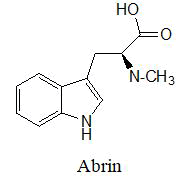
Acacetine and Luteoline
Both of these flavonoids, acacetine and luteoline, isolated from the plant Striga lutea Linn. (Family: Sacrophulariaceae) are responsible for the anti-fertility effect. A dose dependent anti-implantation response was evident for both compounds. These compounds have significant anti-fertility activity in the pre-implantation stages of gestation in rats. These compounds possessed 40%-50% estrogenic potency, as compared to estradiol benzoate [14]. Anti-implantation effect of these flavonoids was due to their estrogenic activity which in turn might be:
• Due to expulsion of ova from the tube.
• Disturb the equilibrium between estrogen and
progestron.

Andrographolide
Andrograholide, isolated from plant Andrograhis paniculata Wall. (Acanteaceae) is a diterpenoid [15-17]. It has shown anti-spermatogenic effect when administered at a dose of 20 mg powder/day/rat for 60 days [18]. The effects of andrographolide on sperm have been reported earlier either negative, positive or no effects. Recently, no toxicity of andrographolide (50 mg/kg) treatment for up to 8 weeks on number and motility of sperm were observed.
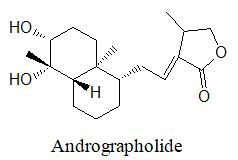
Anethole
It is an aromatic compound isolated from the fruits of Foeniculum vulgare Linn. (Family: Umbelliferae). It is reported that it showed the 60% anti-implantation when administered at a dose of 500 mg/kg for 1-5 days p.c and trans-anethole showed 100% anti-implantation activity at 80 mg/kg p.o. in female rats along with significant estrogenic effect, no anti-estrogenic, progestational, anti-progestational, androgenic or anti-androgenic activity. It also produced anti-implantation effect on female rats and reduced the secretory activity and weight of sex glands [19].
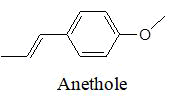
Artemether
Artemether (methyl ether of dihydroartemisinin), is obtained from the herb Artemisia annua L. (Asteraceae). Administration of this compound caused the extensive degeneration of leydig cells and reduction of cholesterol receptors available for binding, thus leading to reduced transport of cholesterol into the cell and subsequently reduction of synthesis of testosterone. It caused significant decrease in sperm count in mice testes when given at a dose of 4.8 mg/kg for 5 days [20].
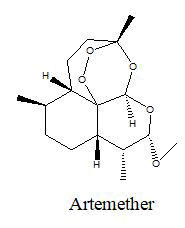
Coumaric acid
P-Coumaric acid, a sesquiterpene compound, isolated from the roots of Aristolochia indica Linn. (Family: Aristolochiaceae) produced 91.7% anti-implantation activity in mice at a single oral dose of 100 mg/kg body weight. It also showed 100% interceptive activity at the single oral dose of 50 mg/kg of body weight when administered on 6th day to pregnant mice.

Aristolic acid
Methyl ester of aristolic acid, a pure compound also isolated from the roots of Aristolochia indica Linn. (Family: Aristolochiaceae), exerted 100% abortifacient activity at a single oral dose of 60 mg/kg body weight when administered on 6th or 7th day of pregnancy and 20, 25% abortifacient effect at the same dose on day 10 and 12, respectively.
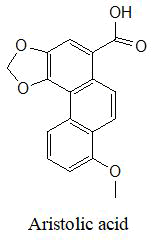
Azadirachtine
It is the constituent isolated from the leaves of plant Melia azadirachta Linn. (Meliaceae). Azadirachtin is a triterpenoid of the class of limonoids, found in three species, the trees Azadirachta indica, A. excels. It has low acute/subchronic toxicity and non-mutagenic/teratogenic in mammalian species, with LD50 greater than 5000 mg/kg in the rat, consequently the possibility of future hazards of neem products therefore should not be ignored. Azadirachtine reduce the sperm count, motility and sperm speed, due to the androgen depletion at the target level particularly in the cauda epididymis thereby effecting the physical maturation of sperm. Anti-implantation or abortiacient action is observed in female rats by activating the cell mediated immune reaction.
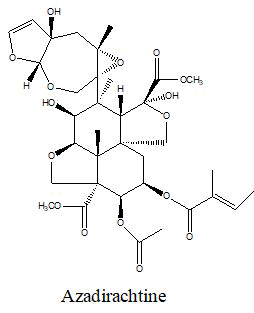
Chalepensin
It is an important constituent isolated from the aerial part of the plant Ruta graveolens Linn. (Family: Rutaceae). It was more effective before implantation. Administration of a suspension of the aerial parts in pre, peri, and post implantation periods showed uniform effect. It show significant antifertility activity in rat when administerd intra gastically on 1-10 post coitus act at early stage of pregnancy. Rue is possibly the plant most used by women with abortive intent, but it might cause multiple organ system failure and death.
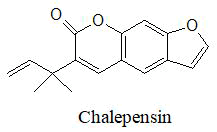
Colchicine
It is an alkaloid isolated from the root of the plant Gloriosa superba Mill. (Family: Liliaceae). G. superba extract indicate that its mechanism of action was neither estrogenic nor progesterone like. However, its early abortifacient activity appears to suggest that its activity is oxytocic. Gloriosa superba showed oxytocic activity and early abortifacient activity which may be due to the presence of alkaloids such as colchicines.
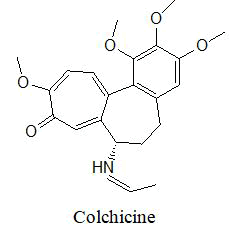
D-pinitol (3-o-methyl-chiroinositol)
It is an active constituent isolated from the leaves of plant Bougainvillea spectabilies Willd. (Family: Nyctaginaceae). Fertility potential test revealed that oral administration of aq. Extract of this plant prolonged metaestrus and decrease the sperm estrogen level whereas in male sperm count decrease along with decrease in testrosterone.
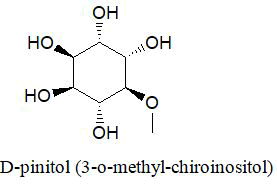
Embelin
It is a bioactive molecule isolated from the fruit of plant Embelia ribs Burm. f. (Family: Myrsinaceae). E. ribes is also reported to have antifertility action. This drug has shown 83% anti-fertility activity in female rats treated with Embelin at a dose of 120 mg/kg post coital from (day 1-15 of pregnancy). Oral doses of Embelin (embolic acid) of 15, 30, 60 and 120 mg/kg on proven fertile females administered on day (1-5 of pregnancy) exhibited 55.55-83.33% anti-implantation activity.
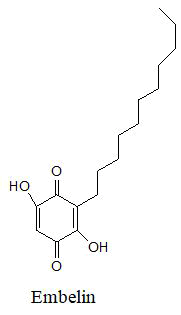
Ergosterol peroxide, β-sitosterol and 5-stigmastene-3β, 7α-diol
These are the major constituents isolated from leaves of plant Ananas comosus Linn. (Family: Bromeliaceae) claimed to have abortifacient property in Indian medician.
• Compound ergosterol peroxide has maximum abortifacient
activity at both stages of pregnancy but action gets delayed when
given after implantation. Loss of weight, lethargy and anaemia of
the treated animals were observed.
• β-sitosterol has delayed action but same side effect and devoid of
activity when given on 6-7 day of pregnancy.
• Most consistent action is because of 5-stigmasteneβ-,3 7α-diol
before and after implantation and without side effect.
Thus 5-stigmastene-3β, 7α-diol is suitable due to absence of side effect as compare to other constituents.

Ferujol
It is an active constituent isolated from the aerial parts of plant Ferula jaesochkeana Linn. (Family: Apicaceae). It has contraceptive activity prevent the pregnancy in adult female rats when administered from day (1-5) post-coitus. Uterine histoarchitecture of treated rat appeared non-receptive for implantation.
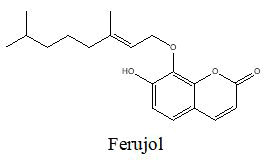
Fraxinellone
It is an active constituent isolated from the root bark of plant Dictamnus albus Linn. (Family: Rutaceae).It shows its anti-fertility effect due to inhibition of implantation. It exerted its action after tubal exit of ova to prevent implantation. It is toxic at the dose of about 1.46 g/kg through p.o route.
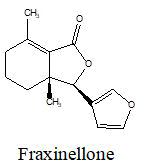
Gamma-sitosterol
There are so many constituents isolated from the plant Ricinus Communis L. (Euphorbiaceae). A bioassay guided fractionation technique was used to separate active components from crude extract. Four phytosterols which were ergost-5-en-3-ol (6.10%), stigmasterol (35.80%), gamma sitosterol (44.77%), and fucosterol (8.40%); and one probucol analog (4.93%). It was presumed that gamma-sitosterol may be the main component contributing to inhibit the viability of DSC (Decidual Stromal Cells). It also causes alteration in the motility, mode of movement and morphology of the sperms. Reductions in the fructose and testosterone levels were suggestive of reduced reproductive performance. Reversibility tests showed that the anti-fertility effect of Ricinus communis was completely reversible on withdrawal of the drug.
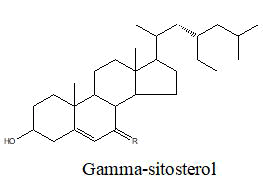
Gossypol
It is a yellow phenolic compound isolated from seed oil of Gossypium herbaceum Linn. (Family: Malvacae). It used as male contraceptive because it reduce the level serum testosterone and Leutinizing Hormone (LH). It acts directly on testes and induce azospermia or oligospermia. The low dose of gossypol (1 mg/kg body wt.) did not have any effect on the following parameters: plasma testosterone concentrations, body growth, kidney weights, sex organ weights (ventral prostate, seminal vesicle, epididymis), testicular weights, blood flow to testes, epididymides and ventral prostate as measured with the microsphere technique, intra-arterial blood pressure and morphology of testis and epididymis. The high dose of gossypol (10 mg/kg body wt) caused signs of tubular degeneration, retarded body growth, markedly reduced testosterone concentrations, involutions of the ventral prostate and seminal vesicles and gastrointestinal disturbances.
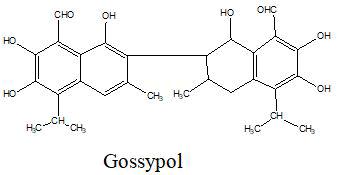
n-hexacosanol, sitosterol, stigmasterol, campesterol
These are the steroid isolated from the plant Heliotropium indicum Linn. (Family: boraginaceae) used as folkloric anti-fertility drug. 50%and 60% abortion was observed in abortifacient activity model with ethanolic extract whereas n-hexane fraction shown 50% and 60%and benzene fractions have shown 30%and 60% abortion. Plant has better abortifacient activity and moderate anti-implantation and sperm motility. 40% anti-fertility activity at a dose of 500 mg/kg in female albino rats.
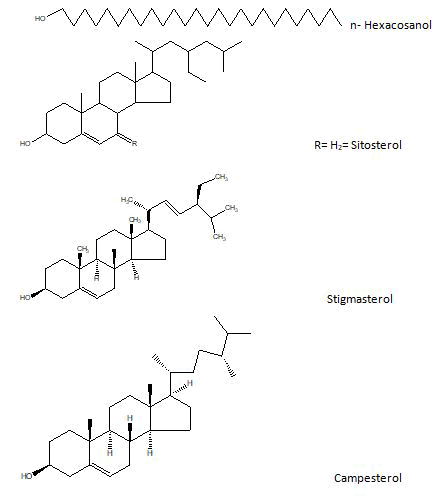
Isothankuniside and thankuniside
It is a chief constituent isolated from the leaf of plant Centella asitica Linn. (Family: Apiaceae). It is an oral antifertility agent causes consistent reduction of fertility in female rats. Crude extract that contains isothankuniside and thankuniside showed anti-fertility action in mice.
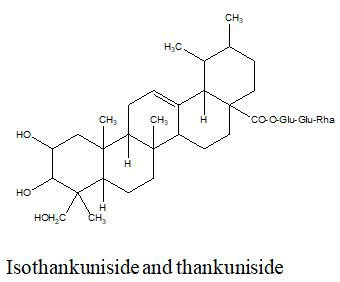
Kampferol, β- sitosterol, ferulic acid, myritic acid, prostaglandine
These are the constituents isolated from the bulb of the plant Allium cepa Linn. (Family: Liliaceae). These constituents are responsible for the anti-implantation activity which is due to anti-zygotic and blastotoxic activity.

Lapachol
Is active phytoconstituent isolated from the genus Tabebuiea (Bignoneaceae). It causes significant reduction in weight of seminal vesicle. Its reproductive toxicity action is due to direct action on seminal vesicle.
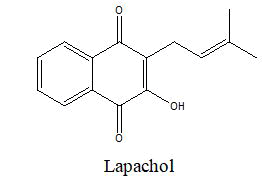
Lupeol acetate
Lupeol acetate, isolated from benzene extract of Alstonia scholaris Linn. (Apocynaceae) in male albino rats. The treatment with lupeol acetate at the dose level of 10 mg/rat/day did not cause any significant change in the body weights, but significant reduction in the weight of reproductive organs, i.e. testes, epididymides, seminal vesicle and ventral prostate, was observed. Testicular sperm count, epididymal sperm count and motility were found significantly declined when compared with controls, which resulted in reduction of male fertility by 100%. The seminiferous tubules appeared reduced in size by 24.62%. Cross-sectional surface area of Sertoli cells as well as their counts was found to be significantly depleted. Leydig cell nuclear area and number of mature Leydig cells were decreased by 27.65 and 35.47%.
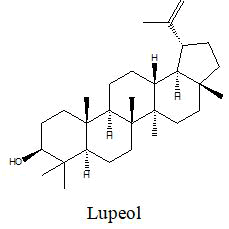
Marsdenikoside A and B
These are the active constituents isolated from the plant Marsdenia koi (Family: Ascelepediacae). Both of this steroidal glycoside has antifertility activity but marsdenikoside A has good anti-fertility activity.
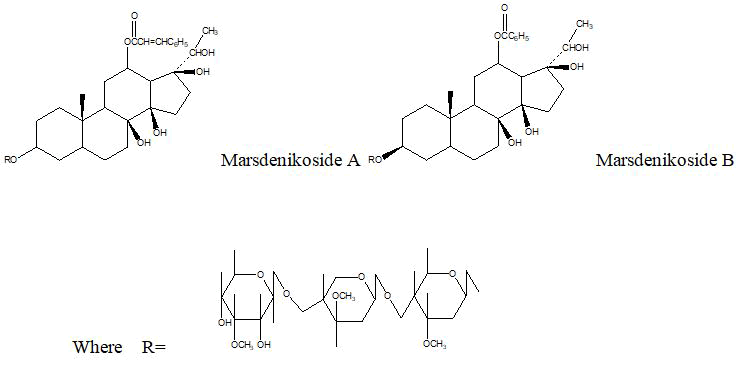
Oleanolic acid
It is a terpene isolated from the flowers of Eugenia jambolana Lam. Myrtaceae. The administration of the compound for 60 days decreased the fertilizing capacity of the animals without any significant changes in body weight or reproductive organ weights. The compound produced arrest of spermatogenesis but did not cause any abnormality to spermatogenic cells, leydig interstitial cells and sertoli cells. Oleanolic acid may prove to be a promising anti-fertility agent devoid of undesirable side effect.
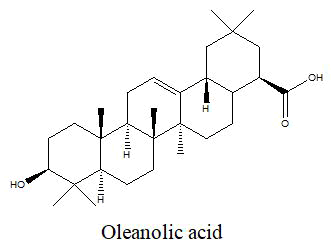
Piperine
It is an important constituent isolated from the fruit of plant Piper longum Linn. (Family: Piperaceae). It has antifertility efficiency ranging from 100-86%. Piperine showed marked increase in serum gonadotropins and a decrease in intratesticular testosterone concentration, despite normal serum testosterone titres. Piperine increased the period of the diestrous phase, which seemed to result in decreased mating performance and fertility. The results showed that piperine interferes with several crucial reproductive events in a mammalian mode. It inhibits the implantation and produce abortion. It also inhibits the uterine contraction but does not possess any action like anti-estrogenic and anti-progestational activity thus piperine has anti-fertility activity without any hormonal imbalance and uterotonic action.
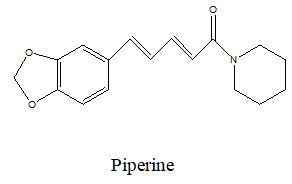
Plumbagin
It is an active constituent isolated from the leaves of plant Plumbago rosea Linn. (Family: Plumbaginaceae). The active constituent reported in this plant are plumbagin, hydroxyl-1,4-napthaguinone, sitosterol glycoside, fatty alcoholandtannin. Flavonoids and plumbagin (napthaquinone) are known to exhibit antifertility activity. The antifertility action of plumbagin seemed to be related to its antiovulatory action. Plumbagin administered by intubation to albino female rats at 10 mg/kg for 15 days significantly inhibited mating and prolonged duration of estrus cycle and diestrus phase. Plumbagin caused a decrease in the number of spermatids, resting and pachytene spermatocytes, and a significant reduction in seminiferous tubule and leydig cell nuclei diameter when given orally to immature Wistar rats at 10 mg/kg for 32 days.
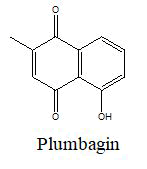
Polysterol and polyphenol
These are isolated from the root bark of the plant Amaranthus spinosus (Family: Amarantheacae). It causes anti-implanation and abortifacient action due to its anti-zygotic and anti-blastocytic activity. These are responsible for the antifertility activity and these compounds exert inhibitory effect on sperm motility.
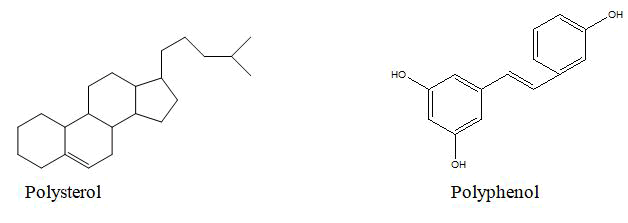
Pseudolaric acid B
It is a diterpenoid isolated from the root of plant Pseudolarix kaempferi Lamb. (Pinaceae) was injected into hamster ovarian bursa with various concentrations before ovulation. The successful rate of fertilization of ova was significantly decreased, but no effect was observed on spermatozoa activity and fertilizing ability. Hamster ova with or without cumulus were treated with PA at a concentration higher than 50 micrograms/ml in the medium, the fertilizing rate of ova was reduced markedly. At the concentration of 5 micrograms/ml, only the capacity of fertilization of the cumulus free ova was inhibited. When PA was injected i.g 20 mg/kg daily to hamsters (female) for 4 d before mating, partial antifertility effect was observed.
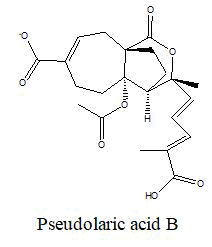
Quassin
These are the active constituents isolated from the stem wood of plant Quassia amara Linn. (Simaroubaceae). Two constituents like Quassin and 2-methoxtcanthin-6-one isolated from this plant by fractionization. Quassin produced similar biological actions as the crude extract while the effects of 2-methoxycanthin-6-one did not seem to differ from those of the control. Quassin appears to be the anti-fertility principle of Quassia amara. It significantly caused a reduction in the weight of the testis, epididymis and seminal vesicle, but an increase in that of the anterior pituitary gland. Epididymal sperm counts, serum levels of testosterone, Luteinizing Hormone (LH) and Follicle Stimulating Hormone (FSH). Basal and LH-stimulated testosterone secretion of Leydig cells isolated from rats pretreated with the extract was inhibited. These changes seemed to be restored eight weeks after the withdrawal from extract treatments.
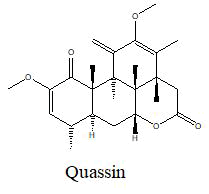
Rohitukine
It is an alkaloid isolated from the stem bark of the plant Dysoxylum binectariferum Hook.f. (Meliaceae). It prevents the pregnancy at the 10 mg/kg dose administered on days 1-7 but was partially (45%) effective at this dose when administered during the entire preimplantation period and ineffective even at 10 times this dose when administered only on day 1 postcoitum, except that there was a significant reduction in implantation number in pregnant females. It is devoid of any estrogen agonistic or antagonistic properties, a mild uterotropic effect without induction of premature opening of vagina or cornification of vaginal epithelium was observed in rohitukine at the 10 mg/kg dose.
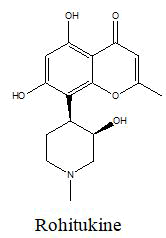
Solasodine
It is an active isolated from the plant Solanam xanthocarpum Schradt. And wendl. (Family: solanaceae). It is an alkaloid possesses anti-spermatogenic activity. Its administration chronically (dose of 20 mg/kg alternate days for 30 days) caused the testicular lesion leading to impairment of spermatogenic element. Epididymides were devoid of spermatozoa. Acid phosphates enzyme acivity of testes was low after the administration of solasodine. Its administration decreases the level of androgens and which causes the reduction in the size of epididymis which lead to epididymal degeneration. Solasodine administion produce infertility in males which is evidenced by the absence of sperm in cauda as experimented in dogs.
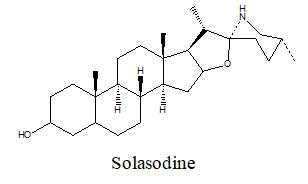
Tinctoramine and tinctoralactone
There are the active steroidal alkaloid isolated from plant Marsdenia tinctoria R. Br (Family: Asclepiadaceae) both have significant anti-implantation and abortifacient activities in mice and rats. These don’t have adverse effect on SGOT, SGPT, BUN, and serum albumin. Both of these isolated compounds produce their action by interruption on normal estrus cycle of rats and mice which aborted under the effect these agents and returned to normal within 6-10 days. Anti-fertility activity of compound is due to presence of steroidal moiety.
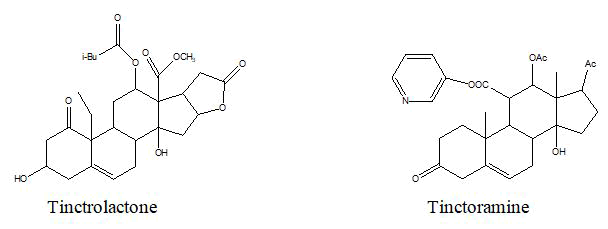
Triptolide
It is an impotent glycoside isolated from the plant T. wilfordii Hook f. (Celastraceae). It causes the reduction in sperm motility and reduction in male rats. Its action is mainly on epididymal sperm with minimal effect on testis. Its spermatogenic action is due to inhibitory action on calcium channel of spermatogenic cells.
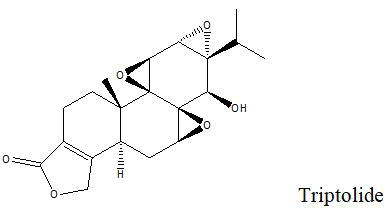
Vicolide B and vicolide D
These active constituents are isolated from the plant Vicoa indica Linn. (Family: Asteraceae). Both of this sesquiterpenoid lactone is reported to have anti-fertility activity. Vicolide B and D exhibited strong abortifacient and anti-implantation activity. It possesses the antifertility activity which is dose dependent and does not produce any side effect. Vicolide B causes the resorption of implant whereas Vicolide D prevents implantation.
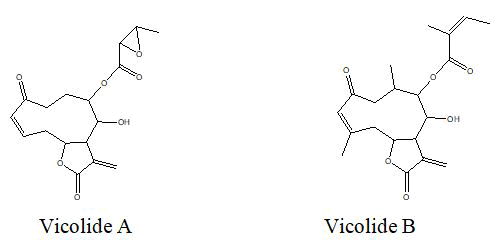
Vinblastine, vincristine
These are the indole-indoline demeric alkaloid isolated from the leaves of plant Catharanthus roseus Linn. (Family: Apocynaceae). It affects the spermetogenic cell line other than spermatogonia. Vincristine decreases the secreatory activity of sex glands. It causes the regression of whole reproductive system.
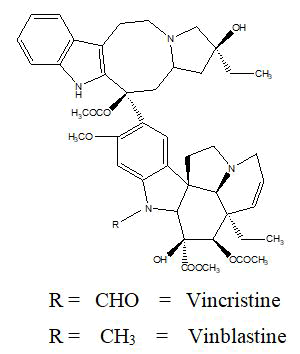
Yuanhuacine
It is a diterpenoid isolated from the flowers of plant Daphne genkwa sieb, et zucc. (Family: Thymalaeaceae). It is responsible for the abortifacient activity of this plant. It produce its action by decreasing the level of progesterone which lead to inflammation, degeneration and necrosis of decidua (mucous membrane formed when conception occur and envelops the impregnated ovum). It shows its action in second trimester not in early stage.
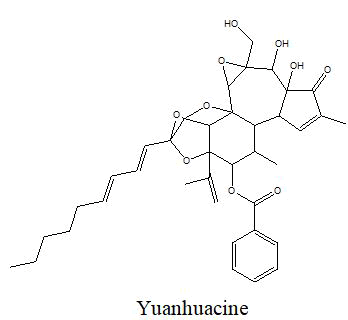
Yuehchukene
It is an active constituent isolated from the root of plant Murraya paniculata Linn. (Family: Rutaceae). It has potent anti-implantation activity in rats at 3 mg/kg orally on pregnancy day 2. Murraya paniculata had a prominent effect of preventing implantation, terminating early pregnancy and mid-pregnancy of mice, but it could hardly prevent the transport of ova.
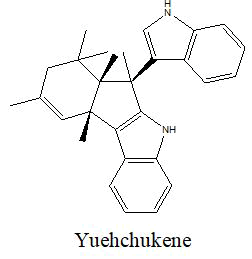
Medicinal plants are used traditionally for the treatment of many diseases from the ancient time. Drastic increase in population is the major problem in now days. Modern system of medicine is mainly concern on the synthetic medicine to inhibit the conception. Synthetic medicines have ill effect on other organ due to their side effect so natural system of traditional medicine is adopted by most of the country to inhibit conception and for anti-fertility activity. This article is mainly concern with active constituents in the plant has reported antifertility activity both in male and female. These constituents inhibit the pregnancy by their different mechanisms. Abridine, has significant contraceptive action but it cause DNA damage of spermatozoa and produce spermatodenic action. Ergosterol peroxide, is a compound has maxium abortifacient activity as compare to other two constituent isolated from the same plant but has side effect like it cause loss of weight, lethargy and anemia in rat. Vicolide B and vicolide D, both isolated from the same plant but anti-fertility activity of vicolide B is 100% as compare to vicolide D. Aristolic acid has 100 % abortifacient activity. Gossypol produce the anti-fertility activity by decreasing the level of testosterone and lutenizing hormone at low dosebut when it is taken at high dose it cause tubular degeneration, retarded body growth, markedly reduced testosterone concentrations, involutions of the ventral prostate and seminal vesicles and gastrointestinal disturbances.
Thus the constituent isolated from plant for their anti-fertility activity also has side effect when these are taken at higher dose so choice for contraceptive constituent should be only to those not cause ill effect on other organs. There are various plants with anti-fertility have been reported but the isolation of constituents responsible for this activity is not an easy task. May this article may helpful in the research of other isolated constituent beneficial in the development of suitable herbal formulation free from side effect and has reversibility of action.
[Crossref] [Google Scholar] [PubMed]
[Crossref] [Google Scholar] [PubMed]
[Crossref] [Google Scholar] [PubMed]
[Crossref] [Google Scholar] [PubMed]
[Crossref] [Google Scholar] [PubMed]
[Crossref] [Google Scholar] [PubMed]
[Google Scholar] [PubMed]
[Crossref] [Google Scholar] [PubMed]
[Crossref] [Google Scholar] [PubMed]
[Crossref] [Google Scholar] [PubMed]
[Crossref] [Google Scholar] [PubMed]
[Crossref] [Google Scholar] [PubMed]
[Crossref] [Google Scholar] [PubMed]
Journal of Pharmacognosy & Natural Products received 606 citations as per Google Scholar report